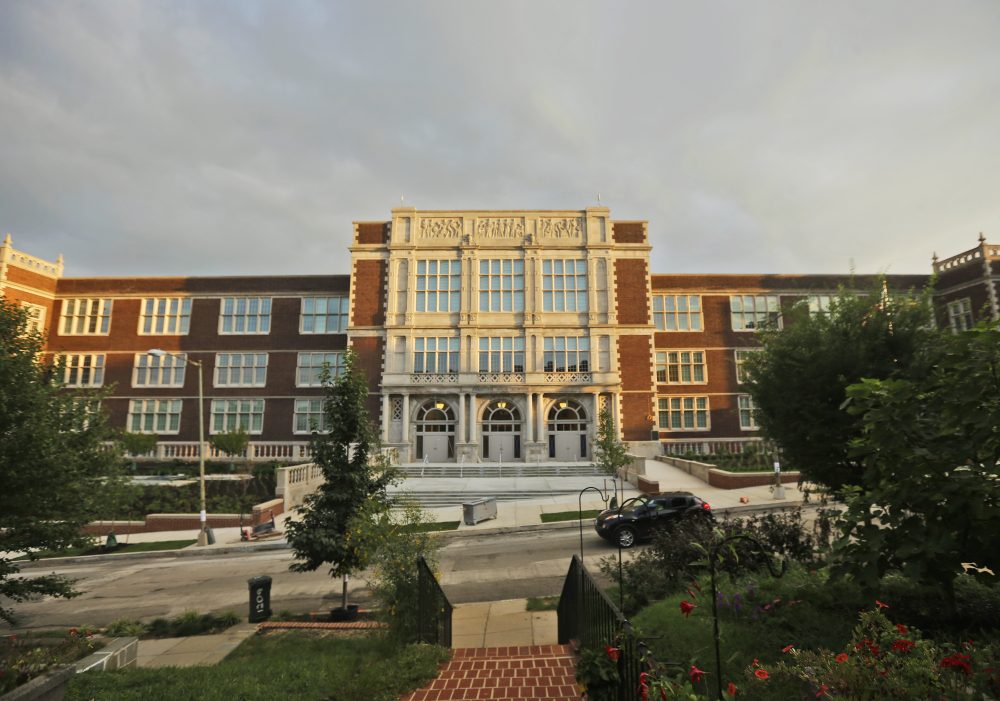Advertisement
Why Some Schools Are Extending The School Day
Resume
School districts around the country have been experimenting with changing the amount of time students spend in school — some have added time to the school year, and some schools in Washington, D.C., Boston and Corpus Christi, Texas, among others, have added time to the school day.
Here & Now’s Jeremy Hobson talks with Maria Ferguson (@mvferg), executive director of the Center on Education Policy at George Washington University, about whether more time in the school day improves learning.
Interview Highlights
On if an "ideal length" for the school day has been determined
"Not really. What we know is that the school day length is contextual. So, depending on the community, it's really best for them to decide what their students need in terms of average school day, school week or school year, because when you talk about expanding time, it could be any variation on that theme. For some people they choose to add hours to the school day, so they may add additional time in the morning or the afternoon. In some communities, they may add time to the school year, so you may actually have a year-round school calendar that breaks up the time students have off throughout the school year, as opposed to having, say, that traditional summer block. There's been a lot of research on this topic about summer loss and school start times, so time, as a resource, and as a tool for learning, has really become a hot topic, and it's, in some ways, a very controversial topic, especially in this country."
On whether more time in school means more learning
"I think the way we tend to think about it is more is not enough; it has to be better. So it has to be more and better learning time. So, the time spent, if you're in a school where the teaching is not of a high quality or the conditions are not conducive to learning, simply providing more of that is not going to do anything for students. It's really adding — making the time that they have far more positive, far more productive, and that it demonstrates yielding results for the students that matter."
On what a positive extension of the school day would look like
"So a good example would be a school that caters — uses their time as something that supports both their students and their teachers. This is one of the things that we have found in our research, that teachers are sometimes the most grateful beneficiaries of not only extra time, but more flexible time. They appreciate having the time to engage in collaborative planning, to do professional development for themselves. It helps make them better teachers, helps make them more effective teachers. For students, say, if you're in a school district that has students that are high impact, low income, struggling with some of the core instructional subjects, having a little bit more time to give them that extra help that they need in reading and math can really make a difference for those students. So it's very situational. School districts that have more resources tend to think about how they use time very differently. It's often for enrichment activities, activities that sometimes cost the parents extra money. So there's this overlay of income that really comes into the use of time in a school district that is both interesting and provocative."
"I think the way we tend to think about it is more is not enough; it has to be better. So it has to be more and better learning time."
Maria Ferguson
On whether it's always bad to shorten the school day
"Yeah, it's pretty much always a bad thing. I mean, unless you're compensating in some other way. In low-end communities, the schools not only provide a source for educating students, but a lot of times it's the source for their meals. Kids can get one, two and in some cases three meals a day at the school. It provides them with a safe haven, perhaps, if their neighborhood is a challenged neighborhood, a neighborhood that's prone to violence. Giving them a safe haven in a school can sometimes be, you know, the only place that they can go to feel safe, and if they have working parents who are working full time, having those parents to then provide child care for the time that their kids are out of school can be an enormous stress factor for them. We've seen this in this area, in the D.C./Maryland/Virginia area — Maryland just changed their school calendar. They used to start before Labor Day weekend, now they start after Labor Day weekend, which was done solely for economic reasons, to ensure that those beach resorts keep making money over the Labor Day weekend. And a lot of educators felt that that was an extremely negative thing to do for students because it goes against what all the research tells us, but, there you have it. So, less time is usually not better."
On where school districts around the country are headed
"We're definitely heading toward more time. More and more districts are embracing this notion that educating students is a far more complex endeavor in the 21st century than it was in previous times and that schools may need to just devote more time to the enterprise. There are some places, though, and, again, not to ding the state of Marlyand — I'm a proud Montgomery County parent, but that has chosen to go in the opposite direction by making their summer time longer than it was in the past. So, I think it all depends on the community and on the students and what the parents want. But, on the whole, yes, we're moving toward more learning time."
This article was originally published on September 13, 2017.
This segment aired on September 13, 2017.